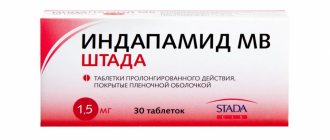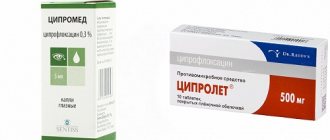Instructions for use OFLOXACIN
It is not the drug of choice for pneumonia caused by pneumococci. Not indicated for the treatment of acute tonsillitis.
It is not recommended to use the drug for more than 2 months. Avoid exposure to sunlight and ultraviolet rays (mercury-quartz lamps, solarium).
In case of side effects from the central nervous system, allergic reactions, pseudomembranous colitis, discontinuation of the drug is necessary. For pseudomembranous colitis confirmed by colonoscopy and/or histology, oral administration of vancomycin and metronidazole is indicated.
It should be borne in mind that when using Ofloxacin-Borimed, rare tendinitis can lead to tendon rupture (mainly the Achilles tendon), especially in elderly patients. If symptoms of tendinitis occur, you should immediately stop treatment, immobilize the Achilles tendon and consult an orthopedist.
When using the drug, women are not recommended to use Tampax-type tampons, due to the increased risk of developing vaginal candidiasis.
During treatment, the course of myasthenia gravis may worsen and attacks of porphyria may increase in predisposed patients.
When using the drug, false negative results are possible in the bacteriological diagnosis of tuberculosis (prevents the isolation of Mycobacterium tuberculosis).
In patients with impaired liver or kidney function, monitoring of plasma concentrations of ofloxacin is necessary. In case of severe renal and hepatic insufficiency, the risk of developing toxic effects increases (dose adjustment is required).
During treatment with the drug, you should avoid drinking alcohol.
Use in pediatrics
In children, Ofloxacin-Borimed is prescribed only when there is a threat to life, taking into account the expected benefits and the potential risk of side effects, when it is impossible to use other, less toxic drugs.
Impact on the ability to drive vehicles and operate machinery
During the treatment period, it is necessary to refrain from driving vehicles and engaging in potentially hazardous activities that require increased concentration and speed of psychomotor reactions.
The drug should be prescribed with caution in case of atherosclerosis of cerebral vessels, cerebrovascular accidents (history), chronic renal failure, QT prolongation, organic lesions of the central nervous system.
Ofloxacin 400 mg 10 pcs. film-coated tablets
pharmachologic effect
Antimicrobial agent - fluoroquinolone.
Composition and release form Ofloxacin 400 mg 10 pcs. film-coated tablets
Solution - 1 ml:
- Active ingredient: ofloxacin - 2.0 mg;
- Excipients: sodium chloride, water for injection.
The theoretical osmolarity value is 314 mOsm/L.
100 ml in orange or colorless glass bottles with a capacity of 100 ml, hermetically sealed with rubber stoppers, crimped aluminum caps or combined aluminum caps with plastic caps.
1 bottle with instructions for use is placed in a cardboard pack.
35 bottles with an equal number of instructions for use are placed in a corrugated cardboard box for hospitals.
Description of the dosage form
Transparent liquid of greenish-yellow color.
Characteristic
Antimicrobial agent from the group of fluoroquinolones.
Directions for use and doses
Inside.
The dose of ofloxacin and duration of treatment depend on the severity and type of infection, the general condition of the patient and renal function.
The average daily dose for adults is from 200 mg to 600 mg. Duration of treatment is 7-10 days.
Doses up to 400 mg/day can be given in one dose, preferably in the morning. Doses over 400 mg/day should be divided into 2 doses at equal intervals. The tablets should be taken whole with water both before and during meals. Concomitant use with antacids should be avoided.
For severe infections or when treating overweight patients, the daily dose can be increased to 800 mg.
For uncomplicated infections of the lower urinary tract, the drug is prescribed at a dose of 200 mg/day for 3-5 days. For gonorrhea, 400 mg is prescribed once.
In patients with impaired renal function, the dose should be reduced depending on creatinine clearance:
| Creatinine clearance | Single dose | Interval between doses |
| 50-20 ml/min | 100-200 mg | 24 hours |
| less than 20 ml/min or hemodialysis | 100 mg | 24 hours |
| hemodialysis less than 20 ml/min or hemodialysis | 200 mg | 48 hours |
In patients with liver failure, it is not recommended to exceed the maximum daily dose of 400 mg.
Pharmacodynamics
Ofloxacin is a broad-spectrum bactericidal antimicrobial drug from the group of fluoroquinolones. The main mechanism of action of quinolones is the specific inhibition of bacterial DNA gyrase. DNA gyrase is essential for bacterial DNA replication, transcription, repair, and recombination. Its inhibition leads to unwinding and destabilization of bacterial DNA and, as a result, to the death of the microbial cell.
Fluoroquinolones have concentration-dependent bactericidal activity and a moderate post-antibiotic effect. The ratio of the area under the curve "convulsive" appetite, headache, nervousness, palpitations or increased pulse rate, pallor of the skin, perspiration, trembling, weakness) requires careful monitoring of the concentration of glucose in the blood plasma. If a patient develops symptoms of decreased plasma glucose concentrations, treatment with ofloxacin should be discontinued immediately and appropriate treatment should be instituted. Treatment with an antibiotic other than a fluoroquinolone should be prescribed if possible.
Patients taking vitamin K antagonists
Due to the possible increase in prothrombin time/international normalized ratio and/or bleeding in patients taking both ofloxacin and vitamin K antagonists (for example, warfarin), regular monitoring of blood clotting parameters is necessary.
Risk of developing resistance
The prevalence of acquired resistance may vary geographically and over time for individual microorganism species. Therefore, local information on resistance is required; Microbiological diagnostics should be carried out with isolation of the pathogen and determination of its sensitivity, especially in severe infections or lack of response to treatment.
Escherichia coli infections
Resistance to fluoroquinolones in Escherichia coli, the most common causative agent of urinary tract infections, varies across geographic regions. Physicians are advised to take into account the local resistance of Escherichia coli to fluoroquinolones.
Infections caused by Neisseria gonorrhoeae
Due to increasing resistance in Neisseria gonorrhoeae, ofloxacin should not be used as empirical treatment for suspected gonococcal urinary tract infection. Susceptibility testing of the pathogen to ofloxacin should be performed to guide targeted therapy. Methicillin-resistant Staphylococcus aureus
There is a high likelihood that Staphylococcus aureus (methicillin-resistant strains) will be resistant to fluoroquinolones, including ofloxacin. Therefore, ofloxacin is not recommended for the treatment of established or suspected infections caused by Staphylococcus aureus (methicillin-resistant strains) unless laboratory tests have confirmed the sensitivity of this microorganism to ofloxacin.
Bone and joint infections
For infections of bones and joints, the need for combined use of ofloxacin with other antibacterial drugs should be considered.
Effect on laboratory parameters and diagnostic tests
Ofloxacin may inhibit the growth of Mycobacterium tuberculosis, leading to false-negative results in the microbiological diagnosis of tuberculosis.
Impact on the ability to drive vehicles and operate machinery
During the treatment period, care must be taken when driving vehicles and engaging in other potentially hazardous activities that require increased concentration and speed of psychomotor reactions. If adverse effects from the nervous system occur, you should refrain from these types of activities.
Overdose
Symptoms: dizziness, confusion, lethargy, disorientation, convulsions, prolongation of the QT interval, nausea and mucosal erosions.
Treatment: in case of overdose, careful monitoring of the patient is required, including ECG monitoring. Treatment is symptomatic. Ofloxacin can be removed from the body through hemodialysis. A specific antidote is not known.
Side effects Ofloxacin 400 mg 10 pcs. film-coated tablets
The information presented below is based on data obtained from clinical studies and extensive post-marketing experience with the drug. The side effects listed below are presented in accordance with the following gradations of frequency of their occurrence: very often (≥1/10), often (from ≥1/100 to
Infectious and parasitic diseases - Uncommon: fungal infections, resistance of pathogenic microorganisms.
Blood and lymphatic system disorders - Very rare: anemia, hemolytic anemia, leukopenia, eosinophilia, thrombocytopenia; Frequency unknown: agranulocytosis, pancytopenia, suppression of bone marrow hematopoiesis.
Immune system disorders - Rare: anaphylactic reactions, anaphylactoid reactions, angioedema; Very rare: anaphylactic shock, anaphylactoid shock.
Metabolic and nutritional disorders - Rarely: anorexia; Frequency unknown: hyperglycemia, hypoglycemia; severe hypoglycemia, up to the development of hypoglycemic coma, especially in elderly patients, patients with diabetes mellitus, taking oral hypoglycemic drugs or insulin.
Mental disorders - Uncommon: agitation, sleep disturbance, insomnia; Rare: psychotic reactions (eg, hallucinations), disturbances of attention, disorientation, agitation, nervousness, memory impairment, delirium, anxiety, confusion, nightmares, depression; Frequency unknown: psychotic reactions and depression with self-harm, in rare cases, even suicidal thoughts or attempts.
Nervous system disorders - Uncommon: dizziness, headache; Rarely: drowsiness, paresthesia, dysgeusia (disorder of taste perception), parosmia (disorder of smell perception); Very rare: peripheral sensory neuropathy, peripheral sensorimotor neuropathy, seizures, extrapyramidal symptoms including tremor, and other disorders of muscle coordination; Frequency unknown: ageusia, increased intracranial pressure.
Visual disorders - Uncommon: irritation of the mucous membrane of the eye, conjunctivitis; Rarely: visual impairment (diplopia, color vision impairment); Frequency unknown: uveitis.
Hearing and labyrinthine disorders - Uncommon: vertigo; Very rare: hearing impairment (tinnitus), hearing loss.
Cardiac disorders - Rare: tachycardia; Uncommon: palpitations; Not known: QT prolongation, ventricular arrhythmias (especially in patients with risk factors for QT prolongation).
Vascular disorders - Common: phlebitis; Rarely: increased blood pressure, decreased blood pressure. During the infusion of ofloxacin, a decrease in blood pressure is possible, accompanied by the development of tachycardia, and which in very rare cases is very pronounced until the development of collapse. If there is a significant decrease in blood pressure, the drug infusion should be stopped immediately.
Disorders of the respiratory system, chest and mediastinal organs - Uncommon: cough, nasopharyngitis; Rarely: shortness of breath, bronchospasm; Frequency unknown: allergic pneumonitis, severe shortness of breath.
Gastrointestinal disorders - Uncommon: abdominal pain, diarrhea, nausea, vomiting, loss of appetite; Rarely: enterocolitis (sometimes hemorrhagic); Very rare: pseudomembranous colitis; Frequency unknown: dyspepsia, constipation, flatulence, pancreatitis, stomatitis.
Liver and biliary tract disorders - Rarely: increased activity of liver enzymes such as alanine aminotransferase (ALT), aspartate aminotransferase (AST), lactate dehydrogenase (LDH), gamma-glutamyl traisferase (GGT) and/or alkaline phosphatase (ALP) and/ or bilirubin concentrations in the blood; Very rare: cholestatic jaundice; Not known: hepatitis, which may be severe; When using ofloxacin (mainly in patients with impaired liver function), cases of severe liver failure, including acute liver failure, sometimes fatal, have been reported.
Skin and subcutaneous tissue disorders - Uncommon: itching, rash; Rarely: urticaria, hyperhidrosis, pustular rash, “flushes” of blood to the skin; Very rare: exudative erythema multiforme, toxic epidermal necrolysis, photosensitivity reactions, drug rash, vascular purpura, vasculitis, which in exceptional cases can lead to skin necrosis; Frequency unknown: Stevens-Johnson syndrome, acute generalized exanthematous pustulosis, exfoliative dermatitis.
Musculoskeletal and connective tissue disorders - Rare: tendinitis; Very rare: arthralgia; myalgia; tendon rupture (for example, Achilles tendon) (as with other fluoroquinolones, this side effect may develop within 48 hours after the start of treatment and can be bilateral); Not known: rhabdomyolysis and/or myopathy, muscle weakness, especially important in patients with myasthenia gravis, muscle tear, muscle rupture, ligament rupture, arthritis.
Nocturnal and urinary tract disorders - Rarely: increased serum creatinine concentration; Very rare: acute renal failure; Frequency unknown: acute interstitial nephritis, increased urea concentration in the blood.
Congenital, hereditary and genetic disorders - Frequency unknown: exacerbation of porphyria in patients with porphyria.
General disorders and disorders at the injection site - Common: pain and redness at the infusion site; Frequency unknown: asthenia, increased body temperature, pain in the back, chest, limbs.
Drug interactions
With theophylline, fenbufen or other non-steroidal anti-inflammatory drugs that lower the threshold for seizure activity in the brain
In clinical studies, no pharmacokinetic interactions of ofloxacin with theophylline were established. However, with the simultaneous use of quinolones and theophylline, non-steroidal anti-inflammatory drugs and other drugs that reduce the threshold of convulsive readiness of the brain, a pronounced decrease in the threshold of convulsive activity of the brain is possible.
With drugs that prolong the QT interval
Ofloxacin, like other fluoroquinolones, should be used with caution in patients receiving drugs that prolong the QT interval (eg, class IA and III antiarrhythmics, tricyclic antidepressants, macrolides, antipsychotics).
With vitamin K antagonists
An increase in prothrombin time/normalized international ratio and/or the development of bleeding, including severe bleeding, was observed with simultaneous use of ofloxacin and vitamin K antagonists (for example, warfarin). Therefore, with the simultaneous use of vitamin K antagonists and ofloxacin, regular monitoring of blood coagulation parameters is necessary.
With glibenclamide
When used simultaneously with glibenclamide, a slight increase in the concentration of glibenclamide and, as a result, hypoglycemia may be observed, which requires monitoring of blood glucose concentrations.
With other hypoglycemic agents for oral administration and insulin
When used simultaneously with other oral hypoglycemic agents and insulin, the risk of hypoglycemia increases and more careful monitoring of blood glucose concentrations is required.
With probenecid, cimetidine, furosemide, methotrexate
With the simultaneous use of quinolones and drugs that are excreted from the body by renal tubular secretion (such as probenecid, cimetidine, furosemide, methotrexate), a mutual slowdown in elimination and an increase in plasma concentrations is possible (especially in the case of high doses).
With drugs that can lower blood pressure, drugs for non-inhalation general anesthesia from the group of barbiturates
When used simultaneously with ofloxacin, a sharp and significant decrease in blood pressure is possible, therefore, in this case, particularly careful monitoring of the functional state of the cardiovascular system is required.
With glucocorticosteroids
Concomitant use of glucocorticosteroids increases the risk of tendon rupture, especially in elderly patients.
With drugs that alkalinize urine (carbonic anhydrase inhibitors, citrates, sodium bicarbonate)
When used with drugs that alkalinize urine (carbonic anhydrase inhibitors, citrates, sodium bicarbonate), the risk of developing crystalluria and nephrotoxic effects increases.
Compatibility with other drugs and infusion solutions Ofloxacin solution should not be mixed with heparin due to the risk of precipitation in the solution.
The drug is compatible with 0.9% sodium chloride solution, Ringer's solution, 5% dextrose solution.





